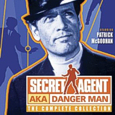Cosgrove Hall (1981), A & E Home Video (May 31, 2005), 2 discs, 306 mins plus supplements, 1.33:1 original full frame ratio, Dolby Digital 2.0 Stereo, Rated G, Retail: $29.95
Storyboard:
Secret Agent Danger Mouse and his assistant Penfold answer the call to defend Her Majesty’s realm from the evil machinations of Baron Silas Greenback.
The Sweatbox Review:
I was quite excited when I heard that A & E would be bringing Danger Mouse to DVD in the U.S. and Canada. I had heard things about this show over the years that made me think that I would quite enjoy it. The series ran in the United Kingdom starting in 1981, and was shown in the United States on Nickelodeon beginning in 1984. Danger Mouse featured the adventures of a secret agent and his sidekick, both of whom happened to be rodents. Brian Cosgrove and Mark Hall conceived the series, with the intention of providing some gentle satire while still telling a ripping yarn.
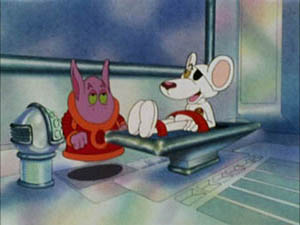
Danger Mouse, like Basil of The Great Mouse Detective, lives on Baker Street in London. And like Basil (or any crime fighter worth his salt), he has an assistant. In this case, a hamster named Penfold serves to provide Danger Mouse with another character to talk to as well as comic relief for the viewer. As competent as Danger Mouse is, Penfold is inept and cowardly. One really wonders how Danger Mouse can put up with him, but one has the impression that DM has maybe been looking out for Penfold since their elementary school days. Regardless, both go on missions as ordered by clueless spymaster Colonel K, whereby they are consistently put into conflict with the nefarious Baron Silas Greenback. Greenback, a frog, is the quintessential bad guy, always conceiving of outlandish plots to destabilize the world and hopefully place him into a role of dictator. Greenback is accompanied always by a pet looking like a huge fuzzy caterpillar, and is assisted by an Italian crow named Stiletto. Greenback’s schemes are notable for their audacity and ridiculousness. Nevertheless, it is always up to Danger Mouse to save the world from Greenback’s diabolical plans.
These plans include everything from standard killer robots to less-common bagpipe robbery, making for an eclectic collection of threats. One of the best parts of the show is seeing the criminal plots being played out, as they get loopier and sillier over the course of the series.
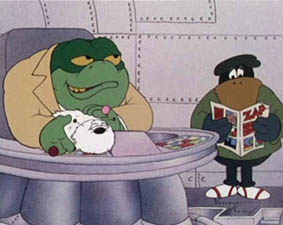
Danger Mouse himself has the redeeming quality of being able to demonstrate extreme competence, while still not being above expressing some rational fear when appropriate. DM rarely becomes a subject of ridicule, leaving that to his boss or Penfold. This sets the show apart from many other spy spoofs, since we can still admire the hero while laughing at the story. However, Danger Mouse does have an exceptionally quick and dry wit, offering plenty of zingers along the way. Penfold is no slouch in the comic dialog department either, easily holding his own when verbal sparring or a bad pun is called for.
I do have a certain fondness for “British humor”, and tend to have a rather dry sense of humor myself. Danger Mouse lives and dies by its sly humor and subtle plays on words, and there are numerous chuckles throughout most of the episodes. Unfortunately, that dryness extends to the personalities too much, and I found myself desperately hoping that someone would come jumping in to inject a little energy into the show. Spy spoofs have come and gone over the years, and while many have been memorable, there are many that have fallen flat. I still love Get Smart, for example, but after the audaciousness of the Austin Powers films, the soft quiet humor of Danger Mouse really left me cold. In fact, for me Danger Mouse committed the ultimate cartoon sin: it bored me.
The animation does little to help the show, either. Considering how much of the humor depends on the dialog, it becomes frustrating to be able to see so little of the dialog being spoken. Character’s mouths are continually hidden, important lines are spoken with the character’s backs to the audience, and certain animals and alien creatures are designed to not even have mouths. Apparently, the Cosgrove-Hall people did not like to worry about lip-synching.
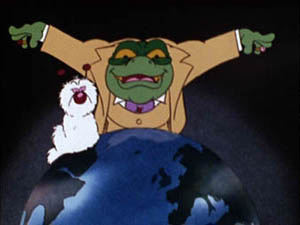
That is not to say that the show does not have some animation highlights, however, as the energy they saved on lip-synching does show up sporadically in a few memorable sequences. The Dream Cloud story gets positively surreal, and the outer space scenes in Custard are fun. At one point in that story, DM goes Tex Avery by re-drawing a map of space to help navigate his way back into the universe! If there had been more scenes like this, I am sure that I would have enjoyed the series a lot more. To be fair, there are plenty of fun ideas present in the stories. I appreciated such notions as a bagpipe farm (Who Stole The Bagpipes), elephants being turned into sugar cubes (Lord Of The Bungle), a stolen bad-luck charm that the owners no longer want returned (The Bad Luck Eye Of The Little Yellow God), and DM not realizing that he was abducted by aliens (Close Encounters Of The Absurd Kind). The drawback to this show is that it is all presented in such a reserved way. I am not a fan of the manic either, but the gags are way too underplayed here. I guess it’s a British thing.
The understated nature of the show extends to the backgrounds as well. The backgrounds contain a mixture of drawings and black & white photography, which provides an interesting effect but also serves to make the show feel all the more static and dead. While there are numerous exceptions, the drawn backgrounds have dull colors and boring textures, and the photographic parts seem moldy and lifeless.
Truth to tell, probably the biggest rush I got out of viewing this set was seeing the old Thames Television ident. Man, that brings back memories! I remember that ident from The Tomorrow People and likely a few other shows I used to watch while growing up on CBC in Canada.
Fans of Count Duckula will probably still really want this set, as the final story, The Four Tasks Of Danger Mouse, contains the vampire’s first appearance (even if he doesn’t seem to be a vegetarian here, since he threatens to take DM’s blood— turns out he’s an ancestor of the guy who got his own show later).

The DVD set has two discs, one per season. The first season’s stories run about 12 minutes, while the second season’s stories have 5 chapters of about 4½ minutes each. I appreciated that each chapter of those stories is given its own chapter on the DVD, making for easy skipping, since each chapter has its own opening and closing credits. This makes sense when you consider that these chapters originally ran daily during the course of a week, making one full story per week.
Is This Thing Loaded?
There’s not much here, I’m afraid. Disc One has two items: The Unaired Pilot (15:06), entitled “Mystery of the Lost Chord”. It is essentially a different version of the Who Stole The Bagpipes episode also seen on Disc One. It is notable for including different voices, and the baron here is called Greenteeth. Other than that, it has the same dull storytelling of the later episodes. For fans, though, this is an essential and important bonus.

The second extra is a set of six Character Biographies, which have little in the way of real information, and instead focus on the writer’s own whimsical comments. Skip.
Case Study:
A & E sticks with its standard format of two keepcases in a slipcover, which is starting to feel antiquated in this era of slimmer packaging. A single-sized 2-disc case could have sufficed and saved me some shelf space. The other drawback is that the exact same image is used on the front and back of the slipcover, and the front and back of both keepcases, as well as smaller chunks of the same image on the spines (and top and bottom of the slipcover!). It just makes the whole thing seem rushed and generic, even though the box is reasonably attractive on first glance.
Ink And Paint:
As I alluded to earlier, the visuals on this show seem designed to put the viewer asleep, and that is largely the fault of the art direction. Of course, this is a matter of personal taste, but I found this to be a fairly unappealing show to watch. The video transfer here only compounds the issue, since it is very grainy and soft, with the additional blight of ghosting in the image. The prints have some physical artifacts, but they are not too bad compared to the bigger problem of overall drabness.
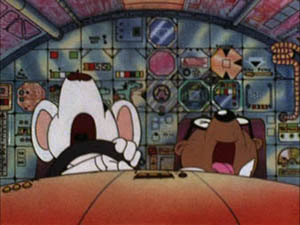
Scratch Tracks:
As if the acting and the video were not enough, the music for Danger Mouse really puts the finishing touch on pushing the viewer into dreamland. The same two pieces of music are used repetitively, which is not so bad when the music is exciting. One of these pieces, the Danger Mouse opening theme, is quite good, providing a much-needed injection of energy into the show when it is used. Unfortunately, the other piece is a slow, jazzy one that seems to exist solely to sap all the viewer’s interest out of the proceedings. It is a nice little instrumental piece really, but wholly inappropriate during, say, a chase sequence.
As for the audio presentation from a DVD standpoint, the sole English language stereo track is wholly uninteresting. It could have easily been a mono track. It does the job, and is largely in keeping with the feel of the show, but I could have done without the hiss that is sometimes heard. No subtitles are offered.
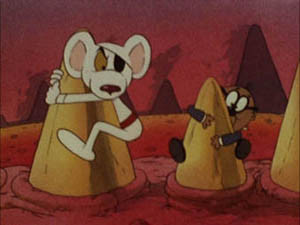
Final Cut:
I am sure that there are still huge fans of the show that will be thrilled to have this DVD set. For the uninitiated, though, there are plenty of other cartoon sets I would recommend before this one. The subdued writing and direction, dull presentation, and lack of extras in this set make it a tough one to recommend, but I certainly encourage fans of the show to voice dissenting positions in our Forum. Maybe I’m missing something!
 | ||
 |








